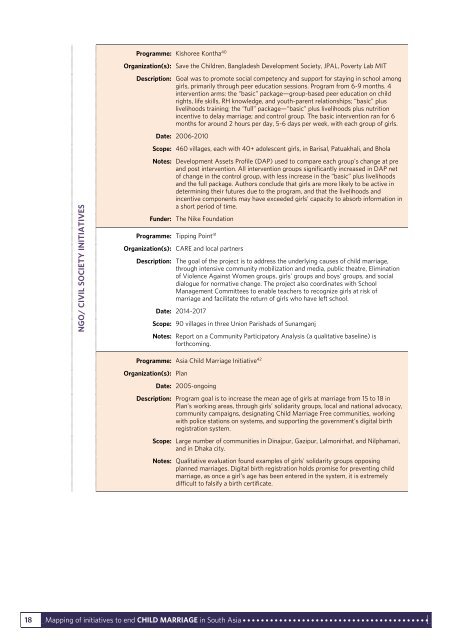CHILD MARRIAGE INITIATIVES
1XYSNQP
1XYSNQP
Create successful ePaper yourself
Turn your PDF publications into a flip-book with our unique Google optimized e-Paper software.
Programme: Kishoree Kontha 40<br />
Organization(s): Save the Children, Bangladesh Development Society, JPAL, Poverty Lab MIT<br />
Description: Goal was to promote social competency and support for staying in school among<br />
girls, primarily through peer education sessions. Program from 6-9 months. 4<br />
intervention arms: the “basic” package—group-based peer education on child<br />
rights, life skills, RH knowledge, and youth-parent relationships; “basic” plus<br />
livelihoods training; the “full” package—“basic” plus livelihoods plus nutrition<br />
incentive to delay marriage; and control group. The basic intervention ran for 6<br />
months for around 2 hours per day, 5-6 days per week, with each group of girls.<br />
Date: 2006-2010<br />
Scope: 460 villages, each with 40+ adolescent girls, in Barisal, Patuakhali, and Bhola<br />
NGO/ CIVIL SOCIETY <strong>INITIATIVES</strong><br />
Notes: Development Assets Profile (DAP) used to compare each group's change at pre<br />
and post intervention. All intervention groups significantly increased in DAP net<br />
of change in the control group, with less increase in the “basic” plus livelihoods<br />
and the full package. Authors conclude that girls are more likely to be active in<br />
determining their futures due to the program, and that the livelihoods and<br />
incentive components may have exceeded girls’ capacity to absorb information in<br />
a short period of time.<br />
Funder: The Nike Foundation<br />
Programme: Tipping Point 41<br />
Organization(s): CARE and local partners<br />
Description: The goal of the project is to address the underlying causes of child marriage,<br />
through intensive community mobilization and media, public theatre, Elimination<br />
of Violence Against Women groups, girls’ groups and boys’ groups, and social<br />
dialogue for normative change. The project also coordinates with School<br />
Management Committees to enable teachers to recognize girls at risk of<br />
marriage and facilitate the return of girls who have left school.<br />
Date: 2014-2017<br />
Scope: 90 villages in three Union Parishads of Sunamganj<br />
Notes: Report on a Community Participatory Analysis (a qualitative baseline) is<br />
forthcoming.<br />
Programme: Asia Child Marriage Initiative 42<br />
Organization(s): Plan<br />
Date: 2005-ongoing<br />
Description: Program goal is to increase the mean age of girls at marriage from 15 to 18 in<br />
Plan’s working areas, through girls’ solidarity groups, local and national advocacy,<br />
community campaigns, designating Child Marriage Free communities, working<br />
with police stations on systems, and supporting the government’s digital birth<br />
registration system.<br />
Scope: Large number of communities in Dinajpur, Gazipur, Lalmonirhat, and Nilphamari,<br />
and in Dhaka city.<br />
Notes: Qualitative evaluation found examples of girls' solidarity groups opposing<br />
planned marriages. Digital birth registration holds promise for preventing child<br />
marriage, as once a girl’s age has been entered in the system, it is extremely<br />
difficult to falsify a birth certificate.<br />
18 Mapping of initiatives to end <strong>CHILD</strong> <strong>MARRIAGE</strong> in South Asia


